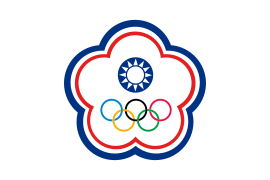Chinese Taipei
"Chinese Taipei" is the name used in some international organizations and competitions for Taiwan (officially the Republic of China; ROC). This name was first proposed in the Nagoya Resolution whereby the ROC/Taiwan and the People's Republic of China (PRC) recognize each other when it comes to the activities of the International Olympic Committee and its correlates. The ROC participates under this name in various international organizations and events, including the World Trade Organization, the World Health Organization, the Metre Convention, and international pageants.



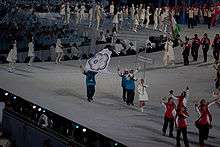
| Chinese Taipei | |||||||||||||||||||||||||||||||||||
|---|---|---|---|---|---|---|---|---|---|---|---|---|---|---|---|---|---|---|---|---|---|---|---|---|---|---|---|---|---|---|---|---|---|---|---|
| Traditional Chinese | 中華臺北 or 中華台北 | ||||||||||||||||||||||||||||||||||
| Simplified Chinese | 中华台北 | ||||||||||||||||||||||||||||||||||
| |||||||||||||||||||||||||||||||||||
| Separate Customs Territory of Taiwan, Penghu, Kinmen, and Matsu | |||||||||||||||||||||||||||||||||||
| Traditional Chinese | 臺澎金馬個別關稅領域 | ||||||||||||||||||||||||||||||||||
| Simplified Chinese | 台澎金马个别关税领域 | ||||||||||||||||||||||||||||||||||
| |||||||||||||||||||||||||||||||||||
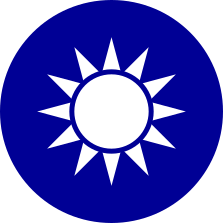 |
|---|
| This article is part of a series on the politics and government of the Republic of China |
|
|
|
|
|
|
|
Related topics |
|
|
The term is deliberately ambiguous. To the PRC, "Chinese Taipei" is ambiguous about the political status or sovereignty of the ROC/Taiwan; to the ROC, it is a more inclusive term than just "Taiwan" (which to the Kuomintang of the ROC in power at the time, and the PRC, is just one part of "China", and both claim to be the rightful government of China in its entirety, and to the PRC the use of "Taiwan" as a national name would imply a de jure independence of Taiwan apart from the PRC) and "Taiwan, China" (might be construed as a subordinate area to the PRC).[1]
Origins
Before the 1600s, the island of Taiwan had numerous independent Taiwanese Aborigines tribes, before being colonized by the Dutch and Spanish colonizers in the northern areas. Small portions of Taiwan were colonized by the Chinese and these few southern areas were governed by the Kingdom of Tungning before being annexed by the Qing dynasty in 1683. The central and mountainous areas were still under Indigenous control. Following the First Sino-Japanese War in 1895, Taiwan was annexed by Japan.
After the Surrender of Japan at the end of World War II, the island of Taiwan was placed under the administration of Nationalist Republic of China (ROC) in 1945 and became their newest province. Near the end of Chinese Civil War in 1949, before the post-war treaties were to be signed, the Kuomintang were driven out of the mainland by the Communists who would later establish the People's Republic of China (PRC) in October 1949. The then ruling-party Kuomintang, however, retreated to the occupied Taiwan, thus becoming government in exile and remained for a time as the internationally recognized government of the Republic of China. Most democratic countries (including the United States) initially continued to support the Nationalist government while communist nations recognized the Communist government.
As time went on, the increased official recognition of the PRC in international activities, such as when accorded recognition in 1971 by the United Nations, instead of that accorded previously to the ROC saw previously existing diplomatic relations transfer from Taipei to Beijing.[2] The ROC needed to come to a beneficial conclusion to how it would be referred when there was in the same forum participation by the PRC.
The International Olympic Committee (IOC), had informally been using in international Olympic activities a number of names to differentiate the ROC from the PRC. "Taiwan" was used at the Tokyo Games.[1] In 1979, the PRC agreed to participate in IOC activities if the Republic of China was referred to as "Chinese Taipei". The Nagoya Resolution sanctioned that the Beijing Olympic Committee would be called the "Chinese Olympic Committee" and another name would need to be found for the ROC Olympic Committee (ROCOC).
The majority view of the ROC leadership at the time was that they did not want to change, "Taiwan" might imply without China or Chinese being in the name subordination to the PRC, did not represent all the regions/islands of the ROC and did not give the ROC an opportunity to assert, when wanted, a claim to territory outside of the ROC.[1]
What people refer to as Taiwan is one of several areas or islands (Penghu, Kinmen and Matsu in addition to Taiwan) and Taiwan alone did not reflect the "territorial extent" of the ROC. Furthermore, although it is true that most products from the area controlled by the ROC are labeled "made in Taiwan", the trade practices of the ROC are such that the regional area of production is used for labeling. Some wines from Kinmen are labeled "made in Kinmen", just as some perfume is labeled "made in Paris" and not "made in France".[1]
Taiwan's own government, the ROC government under the Kuomintang (KMT), rejected the designation of "Taiwan, China" on the grounds that this would imply subordination to the PRC.[1] However, it also refused the names "Taiwan" and "Formosa (simplified Chinese: 福尔摩沙; traditional Chinese: 福爾摩沙)" as a means of reasserting both its claim as the only legitimate government of all of China, and its uncompromising rejection of Taiwan independence. Instead, deriving from the name of its capital city, the ROC government finally formulated the name “Chinese Taipei,” instead of accepting the offer of “Taiwan,” because “Chinese Taipei” signified an uncertain boundary that could exceed the ROC’s actual territory of control of Taiwan, Penghu, Kinmen and Matsu, whenever the ROC government wished to assert it. It regarded the term Chinese Taipei as both acceptably neutral and hopeful of assent from other interested parties. Its proposal found agreement. Beijing accepted the compromise position that the ROC Olympic Committee could be named the "Chinese Taipei Olympic Committee".[1]
In April 1979, in a plenary session of the IOC, He Zhenliang, a representative of the PRC, stated:
According to the Olympic Charter, only one Chinese Olympic Committee should be recognized. In consideration of the athletes in Taiwan having an opportunity to compete in the Olympic Games, the sports constitution in Taiwan could function as a local organization of China and still remain in the Olympic Movement in the name of the Chinese Taipei Olympic Committee. However, its anthem, flag and constitutions should be changed correspondingly.[3]
In November 1979, in Nagoya, Japan, the International Olympic Committee, and later all other international sports federations, adopted a resolution under which the National Olympic Committee of the ROC would be recognized as the Chinese Taipei Olympic Committee, and its athletes would compete under the name Chinese Taipei.[4][5] The National Olympic Committee of the ROC boycotted the Summer and Winter Games in protest of not being allowed to use the Republic of China's official flag and national anthem.[6]
The name "Chinese Taipei" was formally accepted by the Government of the Republic of China in 1981.[7][8] A flag bearing the emblem of its Olympic Committee against a white background as the Chinese Taipei Olympic flag was confirmed in January 1981.[4] The agreement was signed March 23 in Lausanne by Shen Chia-ming, the President of Chinese Taipei Olympic Committee, and Juan Antonio Samaranch, the President of the IOC. In 1983, the National Flag Anthem of the Republic of China was chosen as the anthem of the Chinese Taipei delegation. The Republic of China has competed under this flag and name exclusively at each Games since the 1984 Winter Olympics, as well as at the Paralympics and at other international events (with the Olympic rings replaced by a symbol appropriate to the event).
Translation compromise
Both the Republic of China (ROC) and the People's Republic of China (PRC) agree to use the English name "Chinese Taipei". This is possible because of the ambiguity of the English word "Chinese", which may mean either the state or the culture. In 1979, the International Olympic Committee passed a resolution in Nagoya, Japan, restoring the rights of the Chinese Olympic Committee within the IOC, meanwhile renaming the Taipei-based Olympic Committee "Chinese Taipei Olympic Committee". Since then, and until 1989 the PRC translated "Chinese Taipei" as "Zhongguo Taipei" (simplified Chinese: 中国台北; traditional Chinese: 中國臺北; pinyin: Zhōngguó Táiběi), similar to "Zhongguo Hong Kong", connoting that Taipei is a part of the Chinese state. By contrast, the Republic of China government translated it as "Zhonghua Taipei" (simplified Chinese: 中华台北; traditional Chinese: 中華臺北; pinyin: Zhōnghuá Táiběi) in Chinese, which references the term "China" as the cultural or ethnic entity, rather than the state. In 1981 the former Republic of China Olympic Committee confirmed its acceptance of the Nagoya resolution, but translated "Chinese Taipei" to "Zhonghua Taipei". In 1989, the two Olympic committees signed a pact in Hong Kong, clearly defining the use of "Zhonghua Taipei".[9] The PRC had been observing the Hong Kong pact and using "Zhonghua Taipei" in stipulated areas ever since, but on other occasions, the version of "Zhongguo Taipei" was still in use following past practice, especially in official media references.[10] In the London 2012 Olympic Games opening ceremony, when each country's team proceeds in alphabetical order in English (the host country's language), the Chinese Taipei (TPE) team did not follow China (CHN), but instead took a place in the procession as if its name were "Taipei" or Taiwan, following Syria and preceding Tajikistan instead. However, four years earlier at Beijing 2008 opening ceremony it followed Japan and preceded the Central African Republic.[11] This ordering was based on the stroke number of each team's name in simplified Chinese, the official script in the PRC. Stroke number is often used as the order to arrange teams and person's, akin to the use of alphabetical order in Roman script-based countries.
Other East Asian nations have also had to make unique translation decisions. In Japan, the PRC is referred to by its official Japanese name Chūka Jinmin Kyōwakoku (中華人民共和国), but an English transliteration, Chainīzu Taipei (チャイニーズタイペイ), is used for Chinese Taipei. While in South Korea, the PRC is referred to by its official Hanja name Junghua Inmin Gonghwaguk (중화인민공화국) or (中華人民共和國 in Hanja), whereas Chinese Taipei is referred to as Junghua Taibei (중화 타이베이), which is very similar to the Chinese transliteration.
Use of the name
The name "Chinese Taipei" has spilled into apolitical arenas. The PRC has successfully pressured some religious organizations and civic organizations to refer to the ROC as "Chinese Taipei".[12] The Lions Club used to refer to the Republic of China as "Chinese Taipei", but it now uses the name "Taiwan MD 300".[13] Both the International Monetary Fund[14] and the World Bank[15] refer to the Taiwan as "Chinese Taipei", and "Taiwan" does not appear on the member countries list of either organization. The ICSU also refers to the Republic of China as "China Taipei", right below "China CAST".[16] The Republic of China is a member economy of APEC, and its official name in the organization is "Chinese Taipei".[17] It has also participated as an invited in the World Health Organization (WHO) under the name Chinese Taipei. It is the only agency of the United Nations that the ROC is able, provided it is invited each year, to participate in since 1971.[18]
In the Miss World 1998, the government of the People's Republic of China pressured the Miss World Organization to rename Miss Republic of China 1998 to "Miss Chinese Taipei"; it has been competing ever since under that designation.[19] The same happened in 2000, but with the Miss Universe Organization. Three years later at the Miss Universe pageant in Panama, the first official Miss China and Miss Taiwan competed alongside each other for the first time in history, prompting the PRC government to again demand that Miss Taiwan assume the title "Miss Chinese Taipei". The contestant in question, Chen Szu-yu, was famously photographed holding her two sashes.[20][21] Today, neither Miss Universe nor Miss World, the two largest pageant contests in the world, allow Taiwan's entrants to compete under the Taiwan label. In 2005, the third-largest pageant contest, Miss Earth, initially allowed beauty contestant Li Fan Lin to compete as "Miss Taiwan"; a week into the pageant, however, her sash was updated to "Taiwan ROC". In 2008, the official name for the ROC, was changed to "Chinese Taipei".[22]
The title "Chinese Taipei" leads some people to believe that "Taipei" is a country. During the 2004 Summer Olympics in Athens, while Chinese and Taiwanese news channels referred to the team as Chinese Taipei, most foreign outlets simply called the team Taiwan.[23] For sporting events, the ROC team is abbreviated in Taiwan as the Zhonghua Team (中華隊; Zhonghua, being a more cultural rather than political variation of the term China), which, in effect, labels it the "Chinese Team", in the sense of a "team that is of Chinese ethnicity" as opposed to a "team from China".
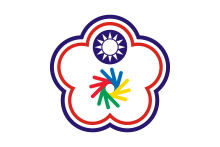
Starting around the time of the 2004 Summer Olympics, there has been a movement in Taiwan to change all media references to the team to the "Taiwanese Team", and the mainstream Taiwan Television (TTV) is one of the first Taiwanese media outlets to do so. Such usage remains relatively rare, however, and other cable TV channels currently refer to the ROC as the Zhonghua Team and the PRC as the Zhongguo Team, the China team or the mainland China team.
In the 2005 International Children's Games in Coventry, United Kingdom, as well as the National Geographic World Championship, the name Chinese Taipei was used too. Chinese Taipei was also the term used by Major League Baseball for the Taiwanese teams that participated in the World Baseball Classic competitions in 2006, 2009, 2013, and 2017, competing under the Chinese Taipei Olympic flag. The Little League World Series also refers to the Taiwanese teams as Chinese Taipei (although the uniforms stated Asia-Pacific). Tennis players play for teams using the Chinese Taipei name and Olympic flag in national competitions such as the Davis Cup, Fed Cup and Hopman Cup.
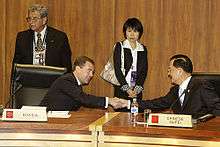
Criticism of the term
Use of the label came under vigorous renewed criticism during the run-up to the 2017 Summer Universiade, hosted in Taiwan. Changing demographics and opinions in the country mean that more than 80% of citizens now see themselves as Taiwanese, not Chinese[24] whereas in 1991 this figure was only 13.6%.[25] This radical upswell in Taiwanese national identity has seen a re-appraisal and removal of "sinocentric" labels and figures established by the government during the period of Martial Law. Moved by a desire to use the country's own national flag and anthem[26] this has included ridiculing the term "Chinese Taipei" not only in the national and international press[27] but by Taiwanese legislators; New Power Party (NPP) Executive Chairman Huang Kuo-chang in particular lambasted the English-language guide to the Universiade for its "absurd" use of the label, illustrating this with statements extracted from the guide rendered nonsensical by their author's insistence on completely avoiding the name "Taiwan" not only when referring to the label under which Taiwanese athletes compete, but even when referring to geographical features such as the island of Taiwan itself. These statements included "Introduction of our Island: [...] Chinese Taipei is long and narrow that lies north to south [sic]," and "Chinese Taipei is a special island and its Capital Taipei is a great place to experience Taipei's culture." Huang added sarcastically, "Welcome to Taipei, Chinese Taipei!"[28]
In response, the guide was withdrawn and shortly thereafter re-issued with the designation "Taiwan" reinstated. The Department of Information and Tourism's division chief explained that Taipei Mayor Ko Wen-Je originally wrote "Taiwan" throughout his introduction of the guide, but that it was changed to "Chinese Taipei" by the International University Sports Federation (FISU) during their review of the document. Due to the public outcry over the controversy, the re-issued "Taiwan" guide was sent for printing without waiting for the response of the FISU.[29]
Taiwan's Social Democratic Party (SDP) member Miao Po-Ya separately criticized the FISU's indiscriminate substitution of "Taiwan" with "Chinese Taipei", pointing out that the "Olympic model" does not prohibit the use of "Taiwan" and citing the example of the 2009 Kaohsiung World Games, in whose material Taiwan was referred to extensively by name, and as a country, without issue.[30]
Miao also claimed that the FISU had also asked organizers to change "Taiwan" to "Chinese Taipei Island" and "New Taiwan Dollar" to "Chinese Taipei Dollar", suggesting that FISU Vice President Liguo Yang (who is also Secretary-General of the Federation of University Sports of China, which is under the control of the Chinese Communist Party) and Xue Yangquing (member of the Federation's media and communication committee) might have exerted China's political influence over the ostensibly non-partisan FISU to downplay Taiwan's national status.[30]
Despite these corrections, hundreds of Taiwanese demonstrated in Taipei, demanding that Taiwan cease using "Chinese Taipei" at sporting events. In a bid to raise international awareness demonstrators unfurled huge banners reading, in English, “Taiwan is not Chinese Taipei” and “Let Taiwan be Taiwan”.[31][32]
In an apparent error, the re-issued guide still contained a passage reading, "Bravo the Bear, the Universiade mascot, is based on the Formosan black bear, a species endemic to Chinese Taipei."[30]
Reporting on the controversy at the opening of the Universiade, the New York Times shared Taiwanese indignation over the designation, writing "Imagine if the United States were to hold a major international event, but one of the conditions was for it to call itself 'British Washington.'"[33]
2018 referendum
However, the Taiwanese people voted during a referendum in November 2018 to reject a proposal to change their official Olympic-designated name from Chinese Taipei to Taiwan.[34] The main argument for opposing the name change was worrying that Taiwan may lose its Olympic membership under Chinese pressure, which would result in athletes unable to compete in the Olympics.[35][36]
Other alternative references to the Republic of China
References used in the international context to refer to the Republic of China or Taiwan differ according to the type of the organization.
Separate Customs Territory of Taiwan, Penghu, Kinmen, and Matsu
The World Trade Organization officially uses "Separate Customs Territory of Taiwan, Penghu, Kinmen, and Matsu" for the Republic of China, but "Chinese Taipei" is frequently used in official documents and elsewhere.[37]
Taiwan
International organizations in which the PRC participates generally do not recognize Taiwan or allow its membership. The ROC is recognized by 14 UN member states and the Holy See. Thus, for example, whenever the United Nations makes reference to Taiwan, which does not appear on its member countries list,[38] it uses the designation "Taiwan, Province of China", and organizations that follow UN standards usually do the same, such as the International Organization for Standardization in its listing of ISO 3166-1 country codes. Certain web-based postal address programs also label the country designation name for Taiwan as "Taiwan, Province of China". Inter-governmental organizations use a variety of terms to designate Taiwan.
In a rare reversal of this tendency, the PRC's state news agency, Xinhua, in July 2017 issued a style guide prohibiting the use of "Taiwan Province" in favor of the preferred name "Taiwan" or "Taiwan Area". Its reason for doing so was ostensibly to "[take] into account the psychological feelings of Taiwanese."[39]
Island of Taiwan/Formosa
The term island of Taiwan or Formosa is used sometimes to avoid any misunderstanding about the Taiwan independence movement just referring to de island.
China or Republic of China
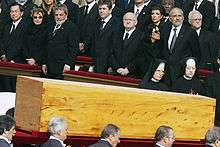
Some non-governmental organizations which the PRC does not participate in continue to use "China" or the "Republic of China". The World Organization of the Scout Movement is one of few international organizations that continue to use the name of "Republic of China", and the ROC affiliate as the Scouts of China. This is because such Scouting in Mainland China is very limited or not really active.[40] Likewise, Freemasonry is outlawed in the PRC and thus the Grand Lodge of China is based in Taiwan.
Countries that maintain diplomatic relations with Taiwan, especially the ROC's older diplomatic affiliates, also refer to the ROC as "China" on occasion; for example, during the funeral of Pope John Paul II, the President of the Republic of China, Chen Shui-bian, was seated as part of the French alphabetical seating arrangement as the head of state of "Chine" between the first lady of Brazil, and the president of Cameroon.
Other non-specified areas
Taiwan is categorized in the United Nations population projections as "Other non-specified areas" within East Asia.[41][42]
See also
References
- Catherine K. Lin (August 5, 2008). "How 'Chinese Taipei' came about". Taipei Times.
- Eyal Propper. "How China Views its National Security," Archived 25 March 2012 at the Wayback Machine The Israel Journal of Foreign Affairs, May 2008.
- Brian B. Pendleton, "The People's Republic of China and the Olympic Movement: A Question of Recognition," Unpublished Doctoral dissertation, The University of Alberta, 1978, p. 115.
- Liu, Chin-Ping (2007). 1981年奧會模式簽訂之始末 (PDF) (in Chinese). Archived from the original (PDF) on March 9, 2012. Retrieved July 8, 2010.
- Chao, Li-Yun (November 2, 2001). 「中華台北」會籍名稱使用事略 (in Chinese). National Policy Foundation. Archived from the original on July 24, 2011. Retrieved July 8, 2010.
- "Winter Olympic Games Lake Placid, USA, 1980". Kiat.net. Archived from the original on June 17, 2012. Retrieved July 27, 2013.
- However, the name of the committee in Chinese continues to be "中華奧林匹克委員會" ("Chinese Olympic Committee"): see Official Website.
- Joe Hung (January 10, 2002). "Chinese Taipei". National Policy Foundation. Archived from the original on July 24, 2011. Retrieved July 9, 2010.
- "Mainland plea to end Taiwan's name issue". China Daily. July 24, 2008.
- "China clarifies Taiwan Olympics team name issue". New Ind Press. July 24, 2008.
- "Taiwanese team will compete as 'Chinese Taipei', Beijing confirms". South China Morning Post. July 24, 2008. Archived from the original on July 16, 2011.
- "Stilblüten" (in German). Archived from the original on June 14, 2008. Retrieved April 7, 2009.
- "Lions Club Locator". Lions Clubs International. November 11, 2008. Archived from the original on December 19, 2008. Retrieved November 22, 2008.
- "IMF reports and publications arranged by country". International Monetary Fund. November 11, 2008.
- "Member Countries & Regions of the World Bank". The World Bank. November 11, 2008.
- "ICSU National Unions". ICSU. 11 November 2008. Archived from the original on 29 January 2009. Retrieved 22 November 2008.
- "APEC FAQ: Who are the members of APEC?". Asia Pacific Economic Cooperation. November 11, 2008. Archived from the original on May 11, 2008.
- Katie Rei d (May 18, 2009). "Taiwan hopes WHO assembly will help boost its profile". Reuters. Retrieved June 11, 2013.
- "Miss World 2008 Contestants". Miss World. November 11, 2008. Archived from the original on July 2, 2014.
- "Chen Szu-yu with her two sashes". Archived from the original on October 14, 2007. Retrieved December 25, 2011.
- "Beauty queen renamed". Taipei Times. May 23, 2003. Retrieved August 9, 2012.
- "85 Beauties Set Their Sights on 'Miss Earth 2008' Crown". Oh My News. November 11, 2008.
- "Rest in peace, 'Chinese Taipei'". Taipei Times. September 1, 2004.
- "Taiwanese identity reaches record high". Taipei Times. May 28, 2016.
- Chang, Rich (March 12, 2006). "'Taiwan identity' growing: study". Taipei Times. p. 3.
- "Many Young Taiwanese Want to Go to the Olympics With a New Flag and Anthem". Time Magazine. November 11, 2016.
- "Taiwan is sick and tired of competing as 'Chinese Taipei' in global sporting events". Quartz. August 8, 2017.
- "NPP blasts 'absurd' English guide to Universiade". Taipei Times. August 9, 2017.
- "UNIVERSIADE: 'Taiwan' back in English media guide". Focus Taiwan. August 11, 2017.
- "Taipei Universiade: 'Chinese Taipei' brochure slammed". Taipei Times. August 13, 2017.
- "Taipei Universiade: Groups call for use of 'Taiwan' at Universiade". Taipei Times. August 13, 2017.
- "'Taiwan is not Chinese Taipei' and 'Let Taiwan be Taiwan' banners". Taipei Times. August 13, 2017.
- "What's in a Name? For Taiwan, Preparing for the Spotlight, a Lot". The New York Times. August 16, 2017.
- "The Latest: Taiwanese reject gay marriage, new Olympic name". The Washington Post. November 24, 2018. Retrieved November 29, 2018.
- https://www.channelnewsasia.com/news/sport/top-taiwan-athletes-speak-out-against-changing-island-s-name-10955272
- Error | Focus Taiwan - CNA English News
- "MEMBER INFORMATION: Separate Customs Territory of Taiwan, Penghu, Kinmen and Matsu (Chinese Taipei) and the WTO". World Trade Organization. November 18, 2008. Retrieved July 27, 2013.
- "United Nations Infonation". The United Nations. November 11, 2008.
- "China forbids terms 'Formosa' and 'Republic of China'". Taiwan News. July 21, 2017.
- Although such organizations are established in the mainland, there is no or less governmental or CPC support to them.
- Basten, Stuart (2013). "Redefining "old age" and "dependency" in the East Asian social policy narrative". Asian Social Policy and Social Work Review.
- "2015 Revision of World Population Prospects". United Nations Department of Economic and Social Affairs. Archived from the original on January 27, 2018. Retrieved August 7, 2015.
External links
| Wikimedia Commons has media related to Flags of Chinese Taipei. |
